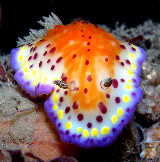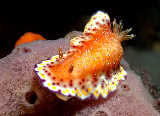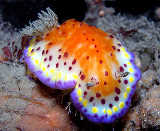Collingwood's Chromdoris
(Chromodoris collingwoodi)
Family: Chromodorididae
"Even though
it has the name Collingwood, it has no colour resemblance to the Australian
AFL team!"
 The
Collingwood's Chromodoris (Chromodoris collingwoodi) is an opisthobranch species
that is a member of the nudibranch family Chromodorididae. The Chromodorididae
family is one of the largest nudibranch families and species within this family
are generally brightly coloured. This species can be found in the waters of
the Western Pacific and the furthest south that it has been recorded on the
east coast of Australia is Sydney in NSW. Its distribution includes the waters
of Indonesia, New Caledonia, Papua New Guinea and along the Great Barrier Reef
in Australia. It is a fairly common species and can be found in sponge gardens
of bays and estuaries and also offshore on coastal reefs.
The
Collingwood's Chromodoris (Chromodoris collingwoodi) is an opisthobranch species
that is a member of the nudibranch family Chromodorididae. The Chromodorididae
family is one of the largest nudibranch families and species within this family
are generally brightly coloured. This species can be found in the waters of
the Western Pacific and the furthest south that it has been recorded on the
east coast of Australia is Sydney in NSW. Its distribution includes the waters
of Indonesia, New Caledonia, Papua New Guinea and along the Great Barrier Reef
in Australia. It is a fairly common species and can be found in sponge gardens
of bays and estuaries and also offshore on coastal reefs.
 The
mantle of Chromodoris Collingwoodi has a purple border and the body of the nudibranch
has a white region with an orange/brownish patch that extends from the front
of the rhinophores (the nudibranchs 'horns') to behind the gills at the back.
Additionally, many bright yellow spots can be found scattered throughout the
white body, generally along the edge of the mantle where the purple border is.
Also, within the white body there are purple spots that are scattered around
the white margin and one other important characteristic is the scattering of
fine white specks all over of the central brown region. The white specks are
most noticeable where they concentrated over the dark purple spots.
The
mantle of Chromodoris Collingwoodi has a purple border and the body of the nudibranch
has a white region with an orange/brownish patch that extends from the front
of the rhinophores (the nudibranchs 'horns') to behind the gills at the back.
Additionally, many bright yellow spots can be found scattered throughout the
white body, generally along the edge of the mantle where the purple border is.
Also, within the white body there are purple spots that are scattered around
the white margin and one other important characteristic is the scattering of
fine white specks all over of the central brown region. The white specks are
most noticeable where they concentrated over the dark purple spots.
 The
rhinophore stalk is translucent whilst the club is a dark reddish brown with
white specks along the edge of the lamellae and a white tip. The gills are translucent
with a dark brown, almost black, line down the two edges of each of the outer
and inner sides. The mantle underside is white with a purple edge and there
is a small purple spot on each of the oral tentacles. The foot is white and
has a row of small bright yellow spots around the edge. This species is often
confused with Chromodoris aureopurpurea however this species differs by having
a white coloured mantle with yellow spots (except at the edge) and the diffuse
purple band around the edge.
The
rhinophore stalk is translucent whilst the club is a dark reddish brown with
white specks along the edge of the lamellae and a white tip. The gills are translucent
with a dark brown, almost black, line down the two edges of each of the outer
and inner sides. The mantle underside is white with a purple edge and there
is a small purple spot on each of the oral tentacles. The foot is white and
has a row of small bright yellow spots around the edge. This species is often
confused with Chromodoris aureopurpurea however this species differs by having
a white coloured mantle with yellow spots (except at the edge) and the diffuse
purple band around the edge.
Chromodoris Collingwoodi is known
to feed on a black encrusting sponge and grows to a maximum size of approximately
10cm.
Back
to Articles
 The
Collingwood's Chromodoris (Chromodoris collingwoodi) is an opisthobranch species
that is a member of the nudibranch family Chromodorididae. The Chromodorididae
family is one of the largest nudibranch families and species within this family
are generally brightly coloured. This species can be found in the waters of
the Western Pacific and the furthest south that it has been recorded on the
east coast of Australia is Sydney in NSW. Its distribution includes the waters
of Indonesia, New Caledonia, Papua New Guinea and along the Great Barrier Reef
in Australia. It is a fairly common species and can be found in sponge gardens
of bays and estuaries and also offshore on coastal reefs.
The
Collingwood's Chromodoris (Chromodoris collingwoodi) is an opisthobranch species
that is a member of the nudibranch family Chromodorididae. The Chromodorididae
family is one of the largest nudibranch families and species within this family
are generally brightly coloured. This species can be found in the waters of
the Western Pacific and the furthest south that it has been recorded on the
east coast of Australia is Sydney in NSW. Its distribution includes the waters
of Indonesia, New Caledonia, Papua New Guinea and along the Great Barrier Reef
in Australia. It is a fairly common species and can be found in sponge gardens
of bays and estuaries and also offshore on coastal reefs. 
